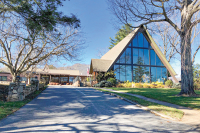Enrollment, retention dip at WCU

Enrollment, retention and freshman interest at Western Carolina University are all down this fall compared to last year, and university leaders are preparing to combat what they believe will be a lingering issue through the pandemic and beyond.
“The impact will be felt not only in our overall enrollment but in our retention metrics as well, since our continuing undergraduate students have also been affected,” Chancellor Kelli Brown said when discussing fall enrollment numbers with trustees at their Sept. 3 meeting . “Looking ahead to next year, numerous efforts are underway to positively impact fall 2022 enrollment.”
Retention, freshmen interest falter
This fall marks the first time since 2015 that WCU posted a fall enrollment figure lower than that of the previous year, with the 11,877 students enrolled as of the 10th day of this semester coming in 3% lower than the 12,243 counted in fall 2020 .
The decrease is due mainly to a “pretty significant decline” in continued enrollment for in-person students, Vice Chancellor for Student Affairs Sam Miller told the Administration, Governance and Trusteeship Committee Sept. 2. A drop in first-time, full-time freshmen contributed as well.
“WCU is best known for its strong academic experiences with small classes and with engaged learning, as well as a dynamic student life opportunity,” Miller said. “The realities of the pandemic impacted both of those experiences, and some students have decided not to continue their enrollment with WCU.”
Related Items
The number of first-time, full-time freshmen fell only slightly compared to fall 2020, at just under 3% — but the 1,780 such students who enrolled last fall represented a 14.55% drop from the previous year.
Last year, WCU posted a record-high enrollment despite the decrease in new freshmen, but an all-time high retention rate and increases in graduate and distance learning buoyed those numbers.
This year, retention cratered.
While 81.4% of first-time, full-time freshmen in fall 2019 returned for the fall 2020 semester, this fall just 74.6% of last year’s freshmen continued their education at WCU. Prior to this semester, retention had been holding mostly steady after meeting the long-held goal of 80% in fall 2015, always remaining within 2% of that figure in the years since. The 74.6% freshman retention rate reported this year is the lowest since 2012, when just 73.7% of the previous year’s freshmen returned to campus.
Retention for the fall 2020 cohort was significantly lower than it’s been for any cohort since the 2011 freshman class. WCU graph
There are some “bright spots” in the 2021 enrollment metrics, said Brown. Distance learning continues to surge, with the number of people enrolled in those programs increasing by 6.3% compared to last fall. Students who are not taking any in-person courses now account for 23.33% of the total student body — though just 17.37% of full-time loads — and their numbers have increased by 38% since 2014. Graduate and transfer enrollment also rose slightly this year, with full-time equivalencies increasing by 13.2% for transfer students and 1.5% for grad students.
The 2021 student body reflects a more diverse group of students, with almost 8% more African Americans, 7.4% more Native Americans and 3% more Hispanic students compared to fall 2019. However, there was a drop in the proportion of male students, who made up only 41.96% of the student body compared to 43.4% in 2019. Until 2020, that figure was between 43% and 44% every year since 2011, and higher in prior years.
Despite a 3% drop in overall enrollment, the student body remains larger than it was for any academic year prior to 2019-2020.
Dashed hopes for ‘normal’
WCU’s struggles are emblematic of what rural public universities are seeing nationwide, Brown told trustees.
“Public four-year college undergraduates in rural areas declined in significantly greater numbers than in our urban counterparts, a trend that is playing out here at Western and affecting our total enrollment — and by extension will have a negative budgetary effect,” she said.
As summer bloomed, so did certainty that the pandemic was on its way out and that fall 2021 would offer a typical college experience. In March, the university announced plans for a “nearly normal” fall semester, and Brown doubled down on that assertion during the June 4 Board of Trustees meeting. The previous day, she had lifted the campus mask mandate for most situations.
But as the Delta variant drove up case numbers throughout July and August, Brown and her staff reconsidered that plan. Masks are once more required in all indoor public spaces, and “strongly encouraged” at crowded outdoor spaces such as football games. Faculty, staff and students are required to get vaccinated or else submit to regular testing. At the Sept. 3 meeting, Brown said that WCU is “committed” to continuing regular activities like in-person classes, sports and campus events but believes that COVID-19 will be a factor “well into the foreseeable future.”
“We are strategically planning our efforts to live with our new normal,” she said.
All that seems to have dampened the interest of prospective students, and the trials of the past year also took their toll on existing students, possibly contributing to decreased retention. During a Sept. 2 meeting of the Academic Affairs and Personnel Committee , Provost Richard Starnes said that pandemic measures such as virtual learning certainly had an impact on student performance.
“Despite having a very good faculty, many of our faculty members were inexperienced at using online or hybrid learning, so they were learning too, and many of them were facing some of the same personal challenges of a lot of people in the world,” Starnes said. “I think we did a good job of implementing the instructional plan we developed for last fall and last spring.”
Regardless, students struggled. Especially in courses meant to be hands-on or gateway courses such as Calculus 1, the university saw a higher-than-normal rate of students who earned a D or F, or who withdrew or audited the course, Starnes said.
With the pandemic now touching its third school year, the university is also battling the downstream impacts of challenges to K-12 education.
“We are seeing already students seeking assistance in the math and tutoring center and in the writing work, which I think reflects a gap from the K-12 system,” said Starnes, during a meeting that occurred as the second week of classes came to an end. “That’s not an insult to the K-12 system. It’s a reality. So I think there will be a gap.”
Enrollment struggles to continue
Looking ahead, university leaders are developing strategies to improve recruiting and retention in the coming years. The plan includes boosting grant and scholarship opportunities and doing a better job of marketing both those opportunities and the cost savings available through the N.C. Promise Tuition Program, which allows in-state undergraduates to attend WCU for just $500 per semester in tuition.
That program is “absolutely” still a competitive draw, Miller said Sept. 2, but WCU has also seen other institutions increase their scholarship funds and financial aid programs to better compete with WCU’s artificially low cost. Additionally, in light of the pandemic students are preferring colleges closer to home, which is a challenge for universities located far from urban centers.
The university will waive all admission fees for spring, summer and fall 2022, and it’s partnering with the Common App platform to make it easier for prospective students to apply. Additionally, student ambassadors with the new Golden Ambassadors program will seek to help the university recruit diverse students. WCU also plans to use federal Higher Education Relief Fund dollars to positively impact enrollment and retention.
The Board of Trustees expects to discuss future strategies further during its November retreat.
While the current enrollment decline is a result of the pandemic, another cliff is on the horizon. When the recession hit in 2008, birthrates declined severely, and they never returned to pre-recession levels when the economy improved. That means that in about five years, the overall number of high school graduates nationwide will start to decline as those recession-era babies start looking at colleges.
The predicted dearth of graduates will be less severe in the South than in the rest of the country, which means that Southern universities could face increased competition from out-of-state schools looking to poach their students.
The university undoubtedly faces challenges. But Brown said that, though lower than desired, this year’s enrollment figures are “laudable” given “this time in history” — a perspective with which Trustee Bryant Kinney agreed.
“I don’t think this tarnishes our brand, and if we allow a drop in the middle of a pandemic to tarnish our brand, that’s our fault,” Kinney said. “Nothing’s changed here with who we are, and let’s not forget that. We’ll be back, we’ll be stronger, and the kids will be back. The world’s changing, and we’ll deal with that.”










